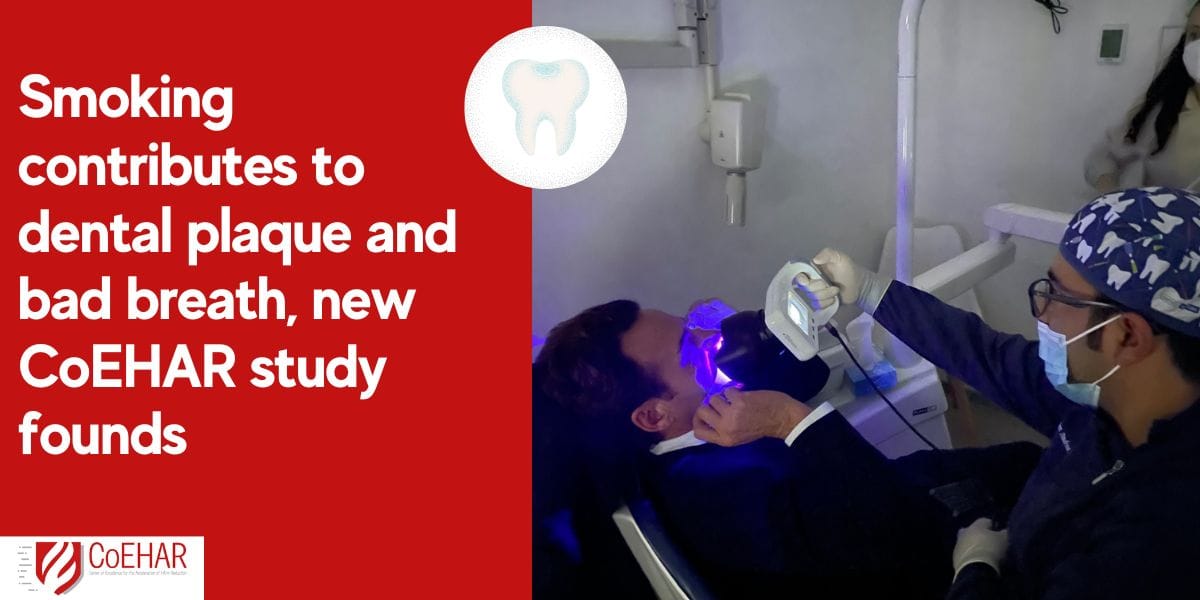CoEHAR researchers of the University of Catania conducted an evaluation of the impact of smoking on the accumulation of dental plaque. Quantification of dental plaque build-up was accomplished using an innovative light-induced fluorescence technology which was employed for the first time. The research findings indicate that smokers have significantly inferior oral health in comparison to non-smokers. Smokers also face an increased risk of developing periodontal diseases.
Catania, 13 July 2023 – Smiling is a form of indirect communication that elicits immediate responses from those around us, promoting immediate physical well-being. It serves as the initial interaction with the community. Unfortunately, the oral cavity is susceptible to the formation of pathologies that undermine both the appearance and the functionality of the smile. Some of which are associated to the onset of dental plaque, a bacterial formation that covers the teeth like a film and which can serve as a precursor to serious periodontal diseases.
Moreover, there is now a substantial body of evidence supporting significant independent links between periodontitis and cardiovascular diseases. Therefore, the accumulation of dental plaque not only deteriorates teeth appearance but also compromises general health.
How can we quantify the damage caused by smoking to the smile?
This question was addressed by an international team of dentists from the University of Bologna, Univeristy Padjadjaran (West Java, Indonesia), Nicolae Testemiţanu” State University of Medicine and Pharmacy (Chişinău, Republic of Moldova) and the University Unit of Periodontics, Oral Health Sciences Centre, Post Graduate Institute of Medical Education and Research (Chandigarh, India) in collaboration with CoEHAR researchers at the University of Catania. They compared measurements of dental plaque among current, former, and never smokers using an innovative light-induced fluorescence technology. Objective quantification of dental plaque was necessary to conduct reliable comparisons between smokers and non-smokers.
“We used a novel light emission-based technology– explains Dr. Gianluca Conte, lead author- that allows accurate measurement of dental plaque and tartar build up. We found that current smokers had consistently higher measures of dental plaque and tartar compared to non-smokers, indicating worse overall oral health due to chronic exposure to cigarette smoke”.
A total of 71 subjects (median age of 33 years) completed the study: 26 current, 20 former, and 25 never smokers. After the first visit, the researchers verified the measurements of dental plaque and tartar build-up at seven, and thirty days to give greater credibility to the findings. Dental plaque build-up was 3-times higher in current smokers compared to former smokers, and never smokers. Current smokers had also the most accumulation of tartar compared to former smokers, and never smokers. The study show that chronic exposure to cigarette smoke is associated with poor oral health.
Using the findings of this study, the authors are now planning to conduct a larger international study that will evaluate dental plaque and tartar build up in smokers switching to alternative tar-free products, such as e-cigarettes and heated tobacco products.
“Daily scrupulous oral care is the cornerstone of foremost oral health. However, unhealthy lifestyles, such as tobacco smoking, can compromise best results of daily oral care and expose people to the risk of serious periodontal diseases. People who wish to improve their oral health and teeth appearance, and reduce their bad breath, should consider stopping smoking” advises Prof. Riccardo Polosa, CoEHAR Founder “and if quitting turns out to be challenging, they should look for ways to reverse the negative impact caused by tobacco cigarettes on oral health by considering tar-free nicotine products. Moreover, for smokers who consider issues like bad breath and compromised dental aesthetics as a significant problem, improvements in dental plaque changes may be a motivating factor to quit smoking”.
Larger studies with more representative age groups are needed to confirm these important findings.




